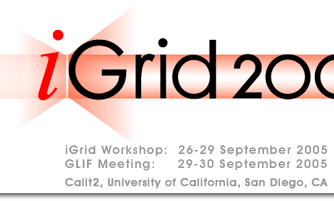20,000 Terabits Beneath the Sea: Global Access to Real-Time Deep-Sea Vent Oceanography
|
URL: www.researchchannel.org/projects www.neptune.washington.edu/index.html www.orionprogram.org www.lookingtosea.org Contact: John Delaney, University of Washington, USA, jdelaney @ thompson.ocean.washington.edu Collaborators: University of Washington (UW), USA: John Delaney, Deborah Kelley, Ron Johnson, Ed Lazowska, Mark Stoermer Scripps Institution of Oceanography, University of California, San Diego (UCSD), USA: John Orcutt, Atul Nayak Calit2, UCSD, USA: Larry Smarr, Matthew Arrott Pacific Northwest GigaPoP, USA: Jan Eveleth Calit2, UCSD, and Electronic Visualization Laboratory, University of Illinois at Chicago, USA: Tom DeFanti ResearchChannel, USA: Mike Wellings, James DeRoest, Amy Philipson, Christopher Latham Real-time, uncompressed, high-definition video from deep-sea, high-temperature venting systems (2.2km, ~ 360 °C) associated with active underwater volcanoes off the Washington-British Columbia coastlines, is transmitted from the seafloor robot JASON to the Research Vessel Thompson through an electro-optical tether. An on-board engineering-production crew delivers a live HD program using both ship-board and live sub-sea HD imagery. This program is encoded in real-time in MPEG-2 HD format, and is delivered to shore via the Galaxy 10R communication satellite using a specialized shipboard HD-SeaVision system developed by the UW and ResearchChannel with early support from HiSeasNet. The MPEG-2 HD satellite signal is downlinked and decoded at the UW in Seattle. The resulting uncompressed HD stream is mixed in real-time with live two-way discussion and HD imagery from participating, land-based researchers working in a studio with undergraduates, K-12 students and teachers. This integrated stream is then transmitted at 1.5Gb to iGrid in San Diego. The transmission utilizes the ResearchChannel’s iHD1500 uncompressed HD / IP software on a Pacific Wave lambda over National LambdaRail. Multicast HD streams of the same production are simultaneously transmitted as 20Mb (MPEG-2) and 6Mb (Windows Media 9) streams. Challenges of this effort include: operating high-definition video in extreme ocean depths amid corrosive, dynamic vent plumes, capturing and processing the video aboard ship, potentially coping with adverse weather, configuring and using satellite links for transmission, and transferring signals from the associated downlink site to a land-based IP network. Exceptional engineering is required to maximize the bandwidth available and to appropriately transmit the video via satellite paths from a moving ship at sea. This appears to be the first live HDTV transmission by cable, from the deep seafloor-to-ship, coupled in real-time with a ship-satellite-shore HD link that is distributed to a broad community of land-based viewers via IP networks. This mission is an early demonstration of next-generation capabilities being explored for NSF’s Ocean Research Interactive Observatory Networks (ORION) program, one potential example being the US-Canadian NEPTUNE project. The demonstration features ongoing research and education supported by the W.M. Keck Foundation, the NSF Ocean Sciences Division and the NSF Office of CyberInfrastructure. Additional support is provided by NOAA’s Coastal Science Center, UCSD’s Calit2, Scripps Institution of Oceanography, and the Woods Hole Oceanographic Institution. The HD activity is partially sponsored by the NSF-funded LOOKING (Laboratory for the Ocean Observatory Knowledge INtegration Grid) project, which is investigating the requisite cyberinfrastructure necessary to support routine, remote Ocean and Earth science / education of the future. |
 |


